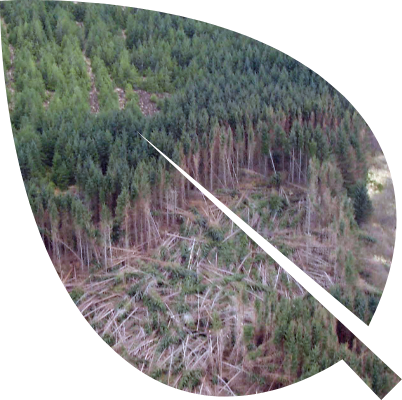Wind is a major threat to woodlands and forests across the United Kingdom, particularly in upland and western areas. Climate change projections include an increased frequency of storms, an increase in wind speeds, and increased rainfall, which are expected to increase the risk of windthrow.
Storm damage has economic, social and ecological impacts including increased harvesting costs and lost revenue, safety concerns for forest workers, and restriction on public access. Wind exposure affects tree growth and stem form, and wind risk constrains forest management in high-risk areas.
Wind risk can be managed by assessing the degree of risk, how it will change as the stand grows, and the impact of potential management actions, and planning species and management accordingly.
The UK experiences frequent storms and high winds, which are a major threat to our forests, especially in upland and western areas. The UK has experience of managing wind risk, however the risk of wind damage and windthrow is expected to increase with climate change, with more frequent storms, an increase in wind speed, an increase in winter rainfall, and faster tree growth.
The projected increase in winter rainfall is likely to increase wind risk, as rooting depth and root anchorage are both reduced in waterlogged soils. An increase in tree growth rate due to warmer temperatures is possible in areas where moisture availability is not limiting, this could increase wind risk with stands reaching a critical height earlier.
Windthrow risk is influenced by:
Wind risk constrains forest management by restricting rotation length, thinning regime, and species selection in high-risk areas. Wind exposure affects tree growth, stem form and timber quality.
Storm damage can increase harvesting costs, reduce timber value, affect amenity value, damage wildlife habitats, restrict public access, close trails, and create safety concerns for forest workers and visitors. Forest facility closures can affect the local economy, by reducing tourism and recreation revenues.
Risk of windthrow is likely to be reduced using the following adaptation measures:

Find out how wind risk was calculated using ForestGALES at one of Scotland’s climate-ready demonstration forests.
For further information on the project see FOSPREF-Wind – Forest Research
This part-animated video tells the story of recent wind damage to European forests – and how scientists are helping manage our forests so that they are better adapted to climate change and more resilient against climate risks.